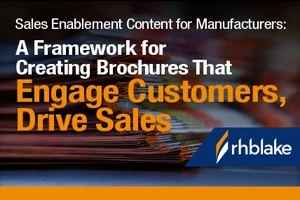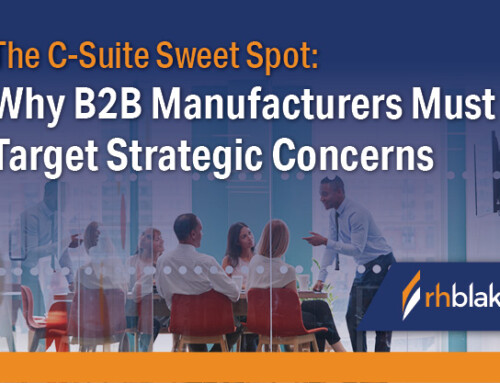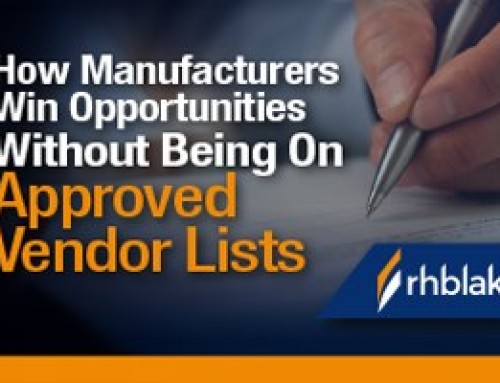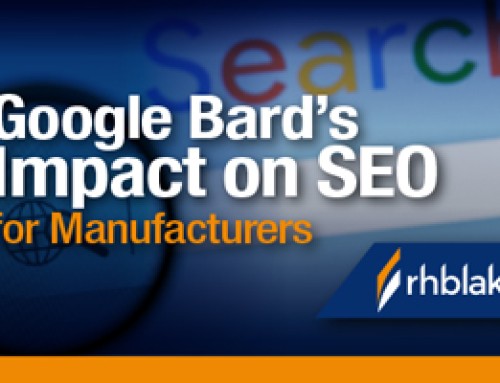Sales Enablement Content for Manufacturers: A Framework for Creating Brochures That Engage Customers, Drive Sales

Written by Dan Konstantinovsky
Strategic Marketing, RH Blake
![]()
Historically, brochures have been part of manufacturing marketing programs. Brochures have proved to be effective leave-behinds for potential customers, allowing them to reference key marketing messages later.
With the accelerating shift toward digital marketing and new sales tools being introduced, however, many marketers wonder whether they should continue incorporating brochures into their sales enablement content toolkits. They wonder if their investment would be better spent on other marketing assets.
Determine the Intent
To decide if brochures should be included in your toolkit, you should first determine their intent. For example, will the brochure:
- Serve as a leave-behind piece?
- Serve as an additional asset that could be used as a nurturing touchpoint?
- Be referenced by your sales team during meetings with potential customers?
- Be used as a lead generator on your website?
- Be used for something else?
Once you’ve determined the primary objective of the brochure, it should become clearer how the brochure would support your overall marketing program compared with another asset or approach.
We’re focusing on sales enablement content now because that’s what’s gaining popularity in the market and because it works. Thus, it’s important to remember that the same old brochure content and format won’t work as effectively as a strategic piece of sales enablement content. In fact, the storyline and format of sales enablement-focused brochures are different than classic manufacturing brochures and need to be aligned with your overall objective.
Appeal to Skim Readers
Before you begin developing your brochure, remember that most folks today – even the most technical – are likely skim readers. That means they usually engage with content by reading only text on certain areas of the page or screen. Research published by Nielsen Norman Group revealed that the eyes of many skimmers tend to follow an F-shaped pattern, as they tend to focus on the top and left sides of the page. Other experts report that users are only reading 20% to 28% of words on a page.
To align with how your target customers consume content, it’s important to create content that features compelling headlines, vibrant images with informative captions and scannable lists and bullets. This guidance certainly applies to sales enablement-focused brochures.
Keep in mind that all key elements within the brochure are considered “hooks” we throw in the water. If the customer becomes engaged by reading even just some of them, they are more likely to go back and read the rest of the brochure and respond to your call to action.
Build Your Brochure
To help you create a strategic sales tool that will support your marketing program, we’ve developed a framework based on a 12-page layout that reflects our best practices. Of course, not every brochure needs to be this length, and you may find opportunities to combine some of these elements.
Cover
- Include the name of the offering as well as visual support. A well-designed cover will grab your customer’s attention while aligning with your corporate identity.
- Include a positioning statement to convey your value proposition to your ideal customer.
- Communicate your offering’s key differentiators to stand out from your competitors.
Why
- Highlight why you are focused on this issue now.
- Explain what life would be like for your target customers if they didn’t address it.
Challenge
- Focus on the issue customers are facing related to their application, facility, industry or
- Demonstrate that you deeply and uniquely understand how the problem you’re proposing to solve fits in (from a level of priority) with all the other challenges your customers are facing.
Solution
- Address how your offering solves the key issue or pain point discussed on the Challenge page.
- Provide supporting details, including features and benefits.
Detailed Features and Benefits
- Extend the story of the Challenge and Solution pages by illustrating the issues customers are facing and detailing how the offering will address them.
- Include an engaging visual of the offering with callouts that highlight key features and benefits.
Impact
- Explain the impact your offering will have on the customer’s business, market, etc.
- Detail how production, cost, safety, regulatory requirements, etc. will be affected.
- Discuss how the impact will align with your target customer’s primary goals and challenges.
Differentiation
- Explain why your offering is better than competing offerings for their unique situation.
- Don’t just look at how your offering compares with competitors but also consider how it compares with indirect competitors.
- Communicate how you will deliver a better customer experience than your competitors.
- Create a sense of urgency by revealing what could happen if the customer does nothing. Many customers know they have an issue but avoid taking action due to the effort and/or risk involved.
Outcome
- Discuss potential outcomes that a customer could expect after moving forward with your offering.
- Feature case studies and use cases as examples.
- Case studies showcase what you’ve done for other customers.
- Use cases reveal what the world could look like if the customer implemented your offering.
- Perform a calculation to show the potential rate of return or payback period.
- Include testimonials that demonstrate potential outcomes driven by your offering.
Advance
- List questions and topics your sales team could discuss with the customer to help determine fit and need.
- Include a clear call to action by outlining the next step(s) for the customer.
Why Us
- Highlight your overall business expertise, capabilities, differentiators and accomplishments.
- Be sure to align these aspects of your business with the particular offering and market.
Back Cover
- List contact information.
Extend the Brochure’s Value
To further extend the value of your brochure, consider:
- Linking to complementary assets from within the content.
- Supporting assets could include videos, online tools, case studies and blog articles.
- Videos are highly effective because they allow a potential customer to see your offering in action. In fact, customers are 85% more likely to purchase a product after watching a video about it.
- QR codes make it easy to link to assets on your website from a printed page.
- Formatting and converting the brochure for online access.
- Giving customers a reason to keep your brochure. Perhaps include a useful template for them to use in their own work.
Build Trust, Accelerate the Sales Cycle
Brochures can be an effective part of a manufacturing marketer’s sales enablement content toolkit – if done right. The Sales Enablement Content Tools for Manufacturers: Brochures template will help you start building your own brochure in line with our best practices. In addition to helping your sales team improve the effectiveness of their sales conversations, sales enablement-focused brochures can also help you accelerate the sales cycle and build trust with your potential customers. The more educated and trusting your customers become, the more likely they are to buy your offering.
Stay tuned for our follow-up article featuring a market research survey about brochures. We’d love to get your input!
Sales Enablement Content for Manufacturers: A Framework for Creating Brochures That Engage Customers, Drive Sales
 Written by Dan Konstantinovsky
Written by Dan Konstantinovsky
Strategic Marketing, RH Blake
![]()
Historically, brochures have been part of manufacturing marketing programs. Brochures have proved to be effective leave-behinds for potential customers, allowing them to reference key marketing messages later.
With the accelerating shift toward digital marketing and new sales tools being introduced, however, many marketers wonder whether they should continue incorporating brochures into their sales enablement content toolkits. They wonder if their investment would be better spent on other marketing assets.
Determine the Intent
To decide if brochures should be included in your toolkit, you should first determine their intent. For example, will the brochure:
- Serve as a leave-behind piece?
- Serve as an additional asset that could be used as a nurturing touchpoint?
- Be referenced by your sales team during meetings with potential customers?
- Be used as a lead generator on your website?
- Be used for something else?
Once you’ve determined the primary objective of the brochure, it should become clearer how the brochure would support your overall marketing program compared with another asset or approach.
We’re focusing on sales enablement content now because that’s what’s gaining popularity in the market and because it works. Thus, it’s important to remember that the same old brochure content and format won’t work as effectively as a strategic piece of sales enablement content. In fact, the storyline and format of sales enablement-focused brochures are different than classic manufacturing brochures and need to be aligned with your overall objective.
Appeal to Skim Readers
Before you begin developing your brochure, remember that most folks today – even the most technical – are likely skim readers. That means they usually engage with content by reading only text on certain areas of the page or screen. Research published by Nielsen Norman Group revealed that the eyes of many skimmers tend to follow an F-shaped pattern, as they tend to focus on the top and left sides of the page. Other experts report that users are only reading 20% to 28% of words on a page.
To align with how your target customers consume content, it’s important to create content that features compelling headlines, vibrant images with informative captions and scannable lists and bullets. This guidance certainly applies to sales enablement-focused brochures.
Keep in mind that all key elements within the brochure are considered “hooks” we throw in the water. If the customer becomes engaged by reading even just some of them, they are more likely to go back and read the rest of the brochure and respond to your call to action.
Build Your Brochure
To help you create a strategic sales tool that will support your marketing program, we’ve developed a framework based on a 12-page layout that reflects our best practices. Of course, not every brochure needs to be this length, and you may find opportunities to combine some of these elements.
Cover
- Include the name of the offering as well as visual support. A well-designed cover will grab your customer’s attention while aligning with your corporate identity.
- Include a positioning statement to convey your value proposition to your ideal customer.
- Communicate your offering’s key differentiators to stand out from your competitors.
Why
- Highlight why you are focused on this issue now.
- Explain what life would be like for your target customers if they didn’t address it.
Challenge
- Focus on the issue customers are facing related to their application, facility, industry or
- Demonstrate that you deeply and uniquely understand how the problem you’re proposing to solve fits in (from a level of priority) with all the other challenges your customers are facing.
Solution
- Address how your offering solves the key issue or pain point discussed on the Challenge page.
- Provide supporting details, including features and benefits.
Detailed Features and Benefits
- Extend the story of the Challenge and Solution pages by illustrating the issues customers are facing and detailing how the offering will address them.
- Include an engaging visual of the offering with callouts that highlight key features and benefits.
Impact
- Explain the impact your offering will have on the customer’s business, market, etc.
- Detail how production, cost, safety, regulatory requirements, etc. will be affected.
- Discuss how the impact will align with your target customer’s primary goals and challenges.
Differentiation
- Explain why your offering is better than competing offerings for their unique situation.
- Don’t just look at how your offering compares with competitors but also consider how it compares with indirect competitors.
- Communicate how you will deliver a better customer experience than your competitors.
- Create a sense of urgency by revealing what could happen if the customer does nothing. Many customers know they have an issue but avoid taking action due to the effort and/or risk involved.
Outcome
- Discuss potential outcomes that a customer could expect after moving forward with your offering.
- Feature case studies and use cases as examples.
- Case studies showcase what you’ve done for other customers.
- Use cases reveal what the world could look like if the customer implemented your offering.
- Perform a calculation to show the potential rate of return or payback period.
- Include testimonials that demonstrate potential outcomes driven by your offering.
Advance
- List questions and topics your sales team could discuss with the customer to help determine fit and need.
- Include a clear call to action by outlining the next step(s) for the customer.
Why Us
- Highlight your overall business expertise, capabilities, differentiators and accomplishments.
- Be sure to align these aspects of your business with the particular offering and market.
Back Cover
- List contact information.
Extend the Brochure’s Value
To further extend the value of your brochure, consider:
- Linking to complementary assets from within the content.
- Supporting assets could include videos, online tools, case studies and blog articles.
- Videos are highly effective because they allow a potential customer to see your offering in action. In fact, customers are 85% more likely to purchase a product after watching a video about it.
- QR codes make it easy to link to assets on your website from a printed page.
- Formatting and converting the brochure for online access.
- Giving customers a reason to keep your brochure. Perhaps include a useful template for them to use in their own work.
- Customizing the brochure for a particular prospect or sales opportunity
Build Trust, Accelerate the Sales Cycle
Brochures can be an effective part of a manufacturing marketer’s sales enablement content toolkit – if done right. The Brochure template will help you start building your own brochure in line with our best practices. In addition to helping your sales team improve the effectiveness of their sales conversations, sales enablement-focused brochures can also help you accelerate the sales cycle and build trust with your potential customers. The more educated and trusting your customers become, the more likely they are to buy your offering.







